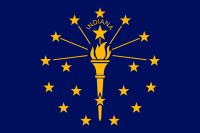
Photo from wikipedia
Objectives: In this study, we aimed to determine the influence of aesthetics and color of printed nutrition education materials on perceived credibility of the material content. Methods: A randomized 2… Click to show full abstract
Objectives: In this study, we aimed to determine the influence of aesthetics and color of printed nutrition education materials on perceived credibility of the material content. Methods: A randomized 2 x 2 (aesthetics and color) factorial experimental design was completed on a university campus. Undergraduate and graduate students (N=204) were randomly assigned one of 4 types of flyers (high aesthetic-color, high aesthetic-black-and-white, low aesthetic-color, and low aesthetic-black-and-white). Perceptions on the flyer content (accurate, believable, biased, valuable, and trustworthy), perceptions of overall flyer quality (attractive, pleasant, confusing, and interesting), and knowledge of the content within the flyer were assessed via a survey after reading the flyer. Results: A statistically significant main effect of aesthetics was observed for perceived "trustworthiness" of the flyer information (p = .048). Flyers with high aesthetics, regardless of print color, had a higher mean score of "trustworthiness" (M = 6.01) than flyers with low aesthetics (M = 5.71). An interaction effect was seen for perception of the flyer being "confusing" (p = .02). The high aesthetic-black-and-white flyer had the highest mean score for "confusing" (M = 1.66) with the low aesthetic flyer printed in color having the second highest mean score for "confusing" (M = 1.56). Conclusions: The aesthetics of nutrition education materials appear to influence perceived trustworthiness of those materials.
Journal Title: American journal of health behavior
Year Published: 2022
Link to full text (if available)
Share on Social Media: Sign Up to like & get
recommendations!